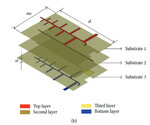Davion
Newbie level 4

Hi,all
I designed a vivaldi antenna immerged in some kind of liquid(the Dielectric constant=37),with a simple rectangular lump port ,the antenna behave well,then I find if I put SMA connector in the simulation,the antenna would behave badly.The SMA connector is made for use in air only? Can someone tell me why?If I made this antenna,could it be usable?
many thanks
I designed a vivaldi antenna immerged in some kind of liquid(the Dielectric constant=37),with a simple rectangular lump port ,the antenna behave well,then I find if I put SMA connector in the simulation,the antenna would behave badly.The SMA connector is made for use in air only? Can someone tell me why?If I made this antenna,could it be usable?
many thanks













